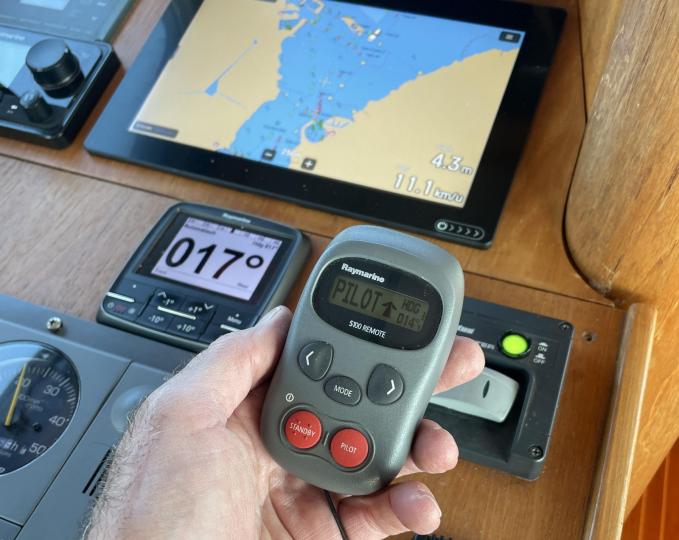News
Navigation and radio requirements for yachts in Europe
In the Netherlands, you need a recreational craft license if your boat is over 15 meters long, and or capable of speeds over 20 km/h.
BHPian Jeroen recently shared this with other enthusiasts
Raymarine equipment can utilize different chart makes. My previous plotter had Navionics charts! With the new kit, I decided to go with Raymarine's house chart brand, Lighthouse.
I have done quite a bit of research and I would say the consensus is that one is not necessarily better than the other. To some degree a personal preference. However, I do believe that Lighthouse is more advanced uses newer techniques, and is likely to start surpassing other chart makers in due course.
Also, and this is relevant to me, the Lighthouse charts, with the correct settings, are almost identical to my paper charts, use identical symbols, and so on. That is relevant to me
In the Netherlands, you need a recreational craft license if your boat is over 15 meters long, and or capable of speeds over 20 km/h. Neither does this apply to Sirion. But of course, I do have all my recreational craft licenses, nonetheless.
You do need a license to operate the VHR Radio. Even when not using the radio, there needs to be somebody on board who is licensed to operate it. The licensing on the radio is split into two parts, the user license and the license for the boat. The boat has a unique Radio Call name, for Sirion PH9422. In addition, it has a so-called MMSI number and an ATIS number. MMSI is related to using the Radio in so-called "sea mode" and ATIS is used for inland waterways.
There is no formal requirement to have a VHF radio on board Sirion. But when you do, you must have the appropriate paperwork, licenses, and registration. Also, on certain waterways, if you have a radio, you have a formal obligation to listen to the appropriate channel and respond to relevant calls!
Radio channels at sea and inland waterways are used differently. Also, on inland waterways, you are supposed to use only 1W transmission power. The VHF radio will automatically adjust the power output when needed.
Just as an example, at sea, the general channel is VHF channel 16. On inland waterways, it is VHF channel 10. So a Mayday is broadcast on channel 16 at sea, but on channel 10 on inland waterways.
Also, most VHF radios are equipped to handle DSC calling in sea mode. Extremely useful as it allows you to put out a Mayday alert, with literally, one push of a button! Does not work on inland waterways.
Calling names, MMSI, and ATIS are unique and are assigned, registered, and licensed to a particular boat.
You might recall I also purchased a mobile handheld VHF radio. It gets the same calling name, MMSI, and ATIS, and is registered to Sirion as well. You are not supposed to use it on other boats, I can use it on a tender (but I don't have one!)
As of the 1st of January, new VHF channel allocations became mandatory. The so-called VDES requirements. One of the problems with my old VHF radio was it could not be updated to these new requirements. Technically that means you are breaking the law and can be fined!
Confused, well even within the EU the rules on boat and radio licensing differ country by country.
And of course, Sirion needed to have a formal CE compliance certificate. See my first posts, as she did not have such a certificate, so the previous owner had to get her re-certified!
About navigating in shallow water: the short answer is you do it with extreme caution.
Obviously, I use charts and an almanac. Talking to other sailors who are familiar with these waters is important too.
Here in the Netherlands, all major waterways will have excellent guidance with buoys. You have to learn the system of course. These buoys are also shown on the chart in my plotter. As long as I stick to being between the buoys I should be good.
Here you see an image from yesterday 4-hour trip:
You see Sirion and just above near the green buoy you see 2,6. Which means 2,6 meters in depth. But a little further up from there, you will see 0,9 which means 90 cm. Sirion draft is 90 cm!!
So it is a combination of eyes out, looking for the buoys, checking your position in the chart and the plotter (which uses GPS), And keeping a very close eye on the depth finder!
I also managed to get the remote control of the auto-pilot going. Just needed a set of new batteries. I showed it to Michael and asked if it would work with the new system. He confirmed, so I got some batteries. I can now control the Sirion rudder from anywhere on the boat! Pretty cool and handy!!
Thank you for those encouraging words. Much appreciated. I suspect I will add to this thread at least once a week, if not more for months to come!!
Yesterday I spent a couple of hours on Sirion with Michael. He has installed all the new Raymarine kit. So we went over all the basic functions. Michael knows Sirion inside out, as he has worked on her for many years. So he also helped me figure out a couple of other things that were not clear to me. (e.g. the battery solar charge versus 220 V inverter system).
This is what is all new. There is more, some components don't show.
Slowly but surely I am beginning to become a little confident.
I spend almost 4,5 hours sailing. Gorgeous weather. Fource 3-4, very sunny, easterly wind, so quite nippy. But with the sun and the heating on, it was very cosy inside Sirion's main cabin!!
I came across the huge floating factory. Not sure what it is, it is not a regular dredger. I think it is used to suck up sand from the bottom of the lake.
Sirion has two flagpost. One at the stern, which is reserved for the Dutch flag.
At the bow, she has a smaller flagpost. Professional ships tend to fly their company flag from it. Recreational crafts often fly the pennant from their home marina.
I could not find the flagpole to fit the one at the bow. I did find an old flagpole in one of the lockers. I took it home, to make it fit and revarnish it.
The first thing was to strip all the old varnish and reshape the end as it was too thick to fit in the flagpole holder.
I made this sort of makeshift wood lathe, using my grinding wheel and a clamp. The vacuum hose is fixed to my bicycle repair stand.
Worked well!! However, I had set my calliper to the wrong dimension, so I turned it to a too-small diameter. Luckily I found a piece of plastic pipe, cut it lengthwise and that makes up the difference once again!!
By now I am applying the 5th coat of varnish. Beginning to look pretty good!!
I have finally, with Michael's help found all relevant online documentation for my Raymarine kit. I have downloaded all the manuals. I am going to get them all printed out. I want my manuals on paper!! Not on a screen!! You would think Raymarine could afford to give you a proper paper manual, at the sort of prices they charge for their kit. But no, everything is digital and you would not believe how many different manuals are listed on their website.
This coming Monday, Mrs D and I will visit Sirion. We have invited Ad (previous owner) and Andre (broker and harbourmaster) for a little ceremony. We have enjoyed working with them. So we are going to have a little handover ceremony before we sail Sirion away to her new birth in Arkel.
Jeroen
Check out BHPian comments for more insights and information.
- Tags:
- Indian
- Member Content
- Yacht
- navigation


















